When you’re in the market for a utility task vehicle (UTV), the decision between purchasing a Can-Am Defender or a Polaris Ranger is a common crossroads. Both UTVs have built reputations for being robust and capable off-road companions, whether it’s for work on your property or for navigating the trails. The Can-Am Defender is known for its hefty towing capacity of up to 3,000 pounds and a higher payload capability, suggesting it’s ready for the more strenuous tasks you might throw its way.
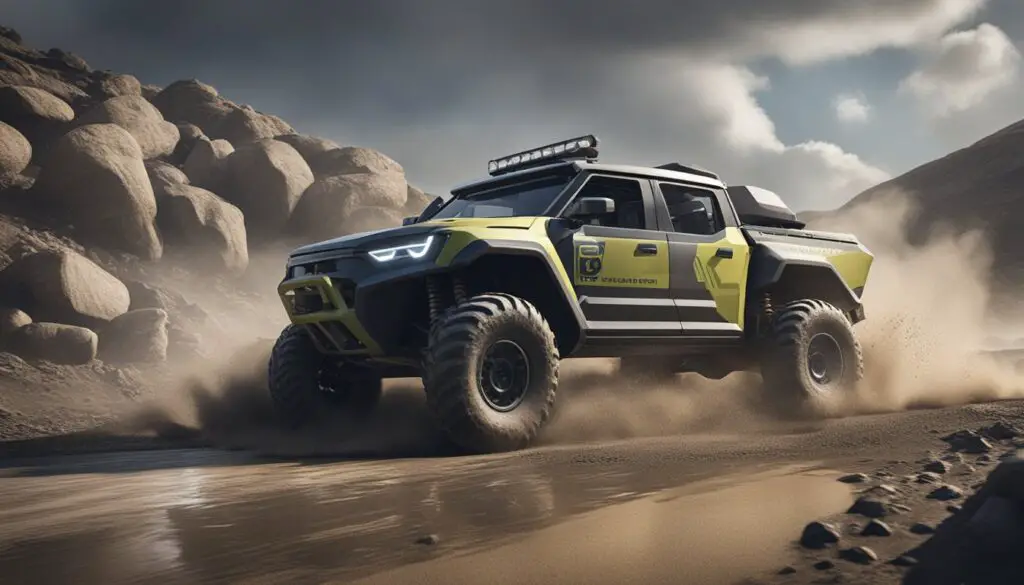
On the other hand, the Polaris Ranger offers a range of sizes including compact two-seaters, making it a possibly more suitable choice for less demanding duties and smaller trails. Though having a lower towing capacity than the Defender, the Ranger still maintains a practical balance between performance and utility.
Deciding between these two UTVs could come down to specific needs like towing and payload capacities, the nuance of handling and comfort, or the diversity in model options. Each model has its unique set of features such as the Ranger’s sleek design to the Defender’s high-strength frame and winching capabilities, which pride themselves on being the best companions for off-road adventures and demanding work duties. So, as you weigh your options, consider what your primary uses will be, the type of terrain you’ll be conquering, and the loads you’ll be hauling.
Overview of The Can-Am Defender vs Polaris Ranger Comparison
As you’re exploring the world of utility terrain vehicles (UTVs), two models likely catch your eye: the Can-Am Defender and Polaris Ranger. These UTVs stand out in the segment with distinctive features and reputations for reliability and performance. In this section, you’ll gain insights into their histories and current market positions.
Brand Histories
Can-Am
- Founded: 1971
- Notable for: Innovation and performance-focused lineup
- Defender Launch Year: 2016, as a robust utility-focused UTV
Polaris
- Founded: 1954
- Famed for: Pioneering the modern snowmobile and a versatile UTV offering
- Ranger Series Debut: 1998, setting the pace in the utility UTV space
Both brands have cultivated deep roots in powersports, evolving from their respective strengths—Can-Am from motorcycles and all-terrain vehicles (ATVs) and Polaris from snowmobiles—to establish strong presences in the UTV market.
Market Position
Can-Am Defender
- Target: Heavy-duty utility and recreational users
- Popular Models: Defender DPS, Defender XT, Defender Limited
Polaris Ranger
- Audience: Range-wide applications from work to leisure
- Standout Models: Ranger 570, Ranger 1000, Ranger XP 1000
The Can-Am Defender and Polaris Ranger cater to both the work-centric and recreation-focused audiences. Each model offers various trims to suit different needs, with the Defender emphasizing towing and payload capacities and the Ranger boasting customizable options and a range of models to meet diverse demands. Both brands have solidified their positions, with Polaris typically leading in sales but Can-Am consistently pushing technological and performance boundaries.
Design and Comfort
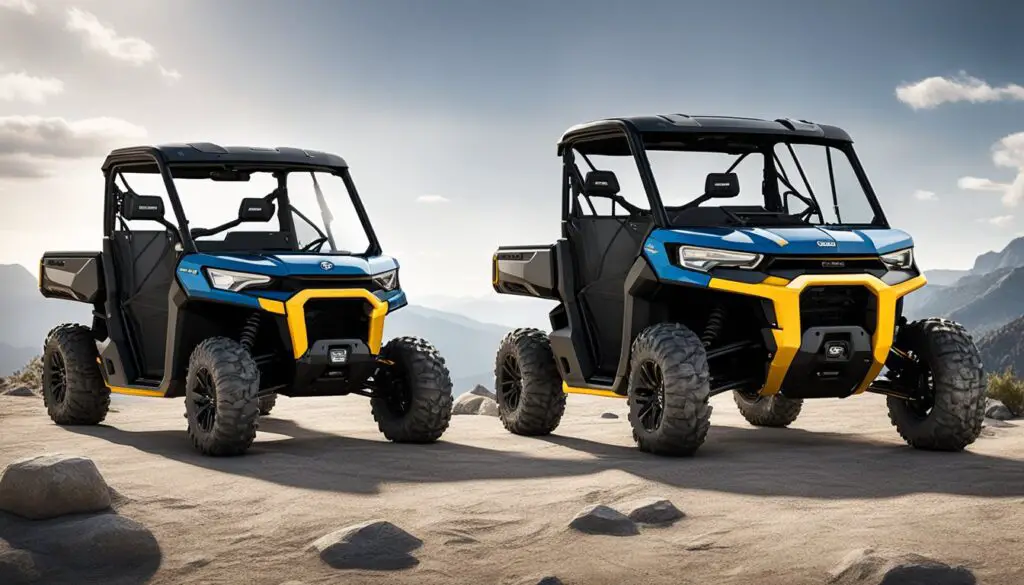
When choosing between the Can-Am Defender and the Polaris Ranger, you’ll notice differences in both exterior and interior designs and a range of comfort features that enhance your riding experience.
Exterior and Interior Design
Can-Am Defender: The Defender boasts rugged lines and a work-oriented design. Your practical needs are met with a spacious cargo bed that’s ready to accommodate wide loads with better bed manipulation features. From a design perspective, the Defender has a versatile dash with ample storage, including a glove box for your essentials.
Polaris Ranger: On the other hand, the Ranger offers a more streamlined design with customizable options. The cargo bed is designed for utility, but with less capacity compared to the Defender. It provides a more recreational look, reflected in its varied color and accessory options that can appeal to your personal style.
Comfort Features
Can-Am Defender: Comfort is key in the Defender, with seats designed for all-day riding. The cab is spacious, allowing you and your passengers to move freely, and the seats come with reassuring seat belts. For convenience, there are multiple cup holders and an option for an enclosed cab, which might include a roof to shield you from the elements.
Polaris Ranger: The Ranger doesn’t skimp on comfort, either. It boasts ergonomic seats and a thoughtful rider experience with easy access to controls. The Ranger can also be equipped with an enclosed cab, ensuring comfort in various weather conditions. Accessorize with roof options to suit your preferences and enjoy a tidy cabin with convenient storage solutions for your adventures.
Engine and Performance
When comparing the Can-Am Defender and Polaris Ranger, you’ll find distinct differences in their engines and performance characteristics that are tailored to meet different needs.
Engine Specifications
Can-Am Defender:
- Engine: Offers two engine options: a 976cc Rotax V-twin engine and a more powerful 1000cc Rotax V-twin engine.
- Horsepower: Depending on the engine, you’ll get either 82 horsepower or up to 100 horsepower.
- Torque: Both engines deliver 69 lb-ft of torque.
Polaris Ranger:
- Engine: Comes with a 999cc DOHC parallel-twin engine.
- Horsepower: Delivers 82 horsepower, matching the lower engine option of the Defender.
Performance Capabilities
Can-Am Defender:
- With the Rotax engines, you’ll experience robust power and a noteworthy driving experience. Your Defender is built to handle both work tasks and leisure rides with ease, ensuring a combination of strength and fun.
Polaris Ranger:
- The power steering and handling capabilities of the Ranger make it adept at traversing challenging outdoor terrain. Its performance is reliable, offering a balanced blend of work and play ability.
Both the Defender and Ranger feature twin-cylinder engines, meaning you can expect a smooth ride along with sufficient power for towing and hauling. The precise engineering behind these machines emphasizes performance that complements the utility side-by-side experience.
Utility and Versatility
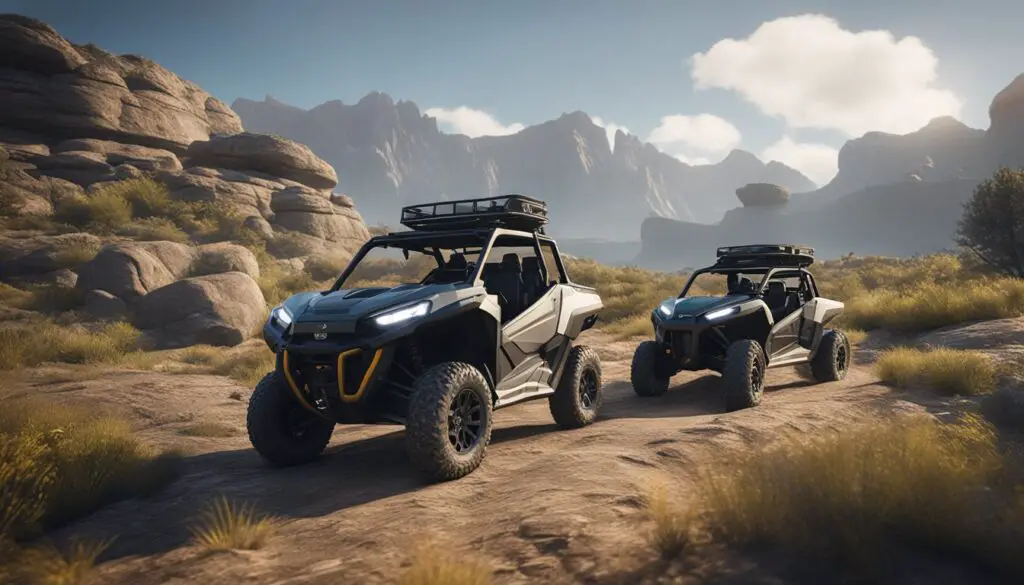
Selecting the right utility vehicle can immensely impact your work efficiency and adaptability to different environments. Both Can-Am Defender and Polaris Ranger offer robust features designed to assist you in various tasks, whether it’s hauling heavy loads or navigating diverse terrains.
Towing and Hauling
Can-Am Defender
- Towing Capacity: Up to 3,000 pounds
- Payload Capacity: Substantial, allowing for heavy items and materials
Polaris Ranger
- Towing Capacity: Up to 1,500 pounds
- Payload Capacity: Less than the Defender, yet capable for moderate hauling tasks
With significant differences in towing and payload capacities, your workload requirements will guide your choice. The Defender excels in towing capacity which can be crucial for heavy-duty jobs.
Cargo and Storage Options
Can-Am Defender offers:
- Bed Capacity: Optimized for more volume and easier bed manipulation to accommodate wide or awkward loads.
- On-board Storage: Ample storage solutions integrated within the vehicle to facilitate organization.
In comparison, Polaris Ranger has a balanced approach, supporting both work needs and recreational use, although with less cargo and storage capacity than the Defender.
Versatility on Various Terrains
Both models boast off-road capabilities, but they have key differences:
Can-Am Defender:
- Ground Clearance: High, with protective A-arms to tackle tough terrains easily.
- Flexibility: Adaptable on varying types of terrain while maintaining stability and control.
Polaris Ranger:
- Ground Clearance: Designed to handle rugged conditions with competence.
- Off-Road Capabilities: It offers reassurance in challenging outdoor scenarios.
Models and Customization
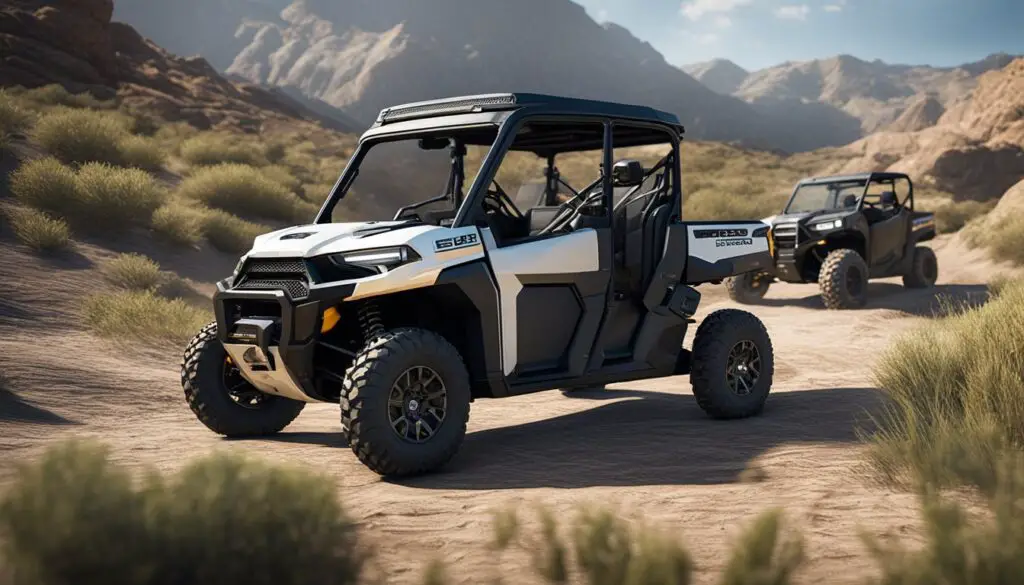
When you’re choosing between the Can-Am Defender and Polaris Ranger, you have a diverse range of models and a wide array of customization options at your fingertips. Whether you need a vehicle for work, play, or a bit of both, the right model and tailored accessories can make all the difference.
Model Variations
Can-Am Defender: The Defender series includes a variety of models like the Defender DPS Cab, designed with your comfort in mind, and the robust Defender XT, equipped with added features such as a winch and EPS for enhanced handling. If you’re looking for luxury, the Defender Limited comes with a full cab and HVAC system for year-round climate control.
- Defender DPS Cab: Full cab with power steering.
- Defender XT: Comes with winch and EPS.
- Defender Limited: Full cab with HVAC system.
Polaris Ranger: On the other side, Polaris offers the Ranger 570 Full-Size for those who desire a mix of performance and economy, and the Ranger 1000 that boasts more power for the heavy-duty tasks. If you have a crew, there are ‘Crew’ versions that can accommodate multiple passengers without sacrificing performance.
- Ranger 570: A compact two-seater.
- Ranger 570 Full-Size: Balances performance and affordability.
- Ranger 1000: High power for demanding jobs.
- Ranger Crew: More seats for additional passengers.
Customization and Accessories
Your UTV can be customized to fit your specific needs with a plethora of accessories and package variations available for both the Defender and Ranger models. They come with the flexibility to add on what you need, creating a machine that’s tailored just for you.
Can-Am Defender: The Defender thrives on customization with options to add extra storage, winch systems, and more. With the ability to pick and choose, you can tailor your Defender to your exact specifications.
- Add winches, extra storage capabilities, and specialized accessories for your unique tasks.
Polaris Ranger: Polaris is not to be outdone, offering an extensive catalog of accessories. You can boost functionality with a variety of add-ons, from EPS to enhance steering, to customized tires and more.
- Upgrade with EPS, specialized tires, and functional accessories to enhance your Ranger’s capabilities.
Riding Experience and Accessibility
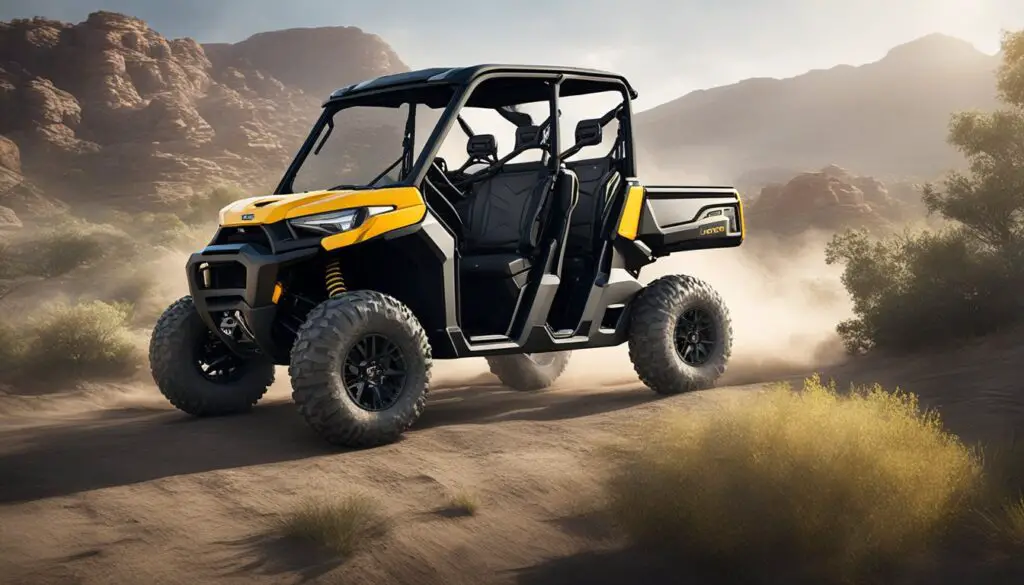
When choosing between the Can-Am Defender and Polaris Ranger, your riding experience hinges on how each vehicle handles and the level of comfort and accessibility they offer. Let’s dive into how these aspects can affect your time behind the wheel.
Handling and Suspension
The Can-Am Defender is praised for its adaptability and the speed it can attain. Its suspension system is designed for an engaged riding experience, with a wheelbase and shocks that handle higher speeds smoothly. On the other side, the Polaris Ranger is known for its solid handling in tough outdoor conditions, which might be attributed to its suspension and dampening rates that provide steadiness at lower speeds.
- Can-Am Defender:
- Wheelbase allows for speedy yet controlled rides
- Suspension system built for versatility
- Polaris Ranger:
- Dampening and rebound rates tailored for stability
- Better suited for rough terrain handling
Rider Comfort and Accessibility
Your comfort in a UTV is essential, especially when spending long hours on tasks. The Can-Am Defender boasts an enclosed cab that shields you from the elements while maintaining a quiet atmosphere for a more pleasant ride. The plush seats also add to the comfort factor. The Polaris Ranger, with its practical design elements, offers a balance between work and play, ensuring that you have a comfortable ride without sacrificing functionality.
- Can-Am Defender:
- Enclosed cab for a quieter, sheltered riding environment
- Comfort-focused seating arrangement
- Polaris Ranger:
- Accessible and functional design promoting rider comfort
- Harmonious blend of utility and rider-centric features
Safety and Protection
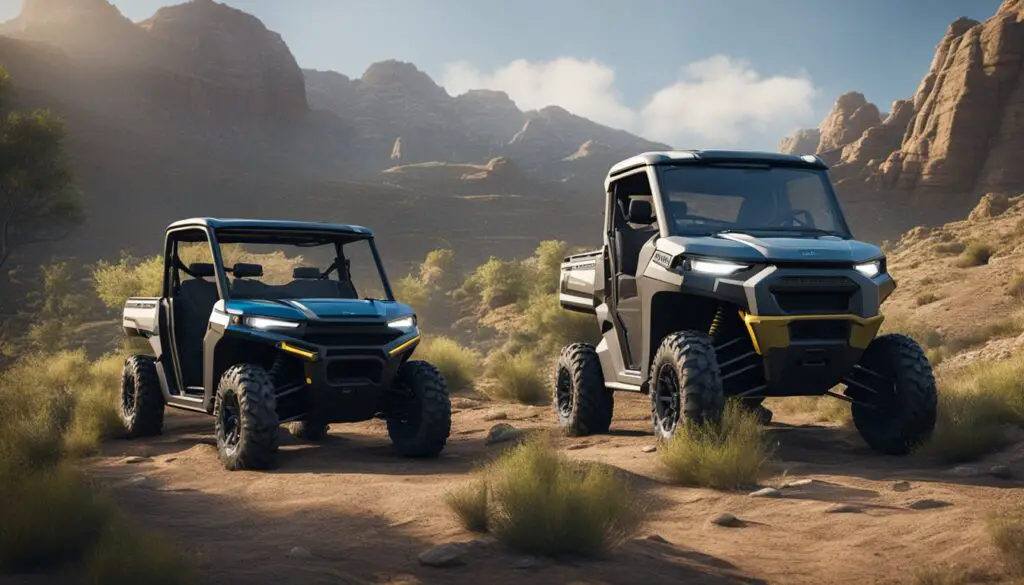
When comparing the Can-Am Defender and Polaris Ranger, it’s important to evaluate the safety features each offers to ensure your weekends are worry-free, whether you’re on the farm or hitting the trails.
Built-in Safety Features
Can-Am Defender: The Defender promotes safety with sturdy ROPS (Roll Over Protection Structures), keeping you secure in the event of a tip-over. Moreover, you’ll appreciate the three-point seat belts and adjustable driver’s seat, which ensure a proper fit for your protection. Here’s a quick look at its safety features:
- ROPS (Roll Over Protection Structures)
- Three-point seat belts for all passengers
- Adjustable driver’s seat for proper fit and control
Polaris Ranger: The Ranger also takes your safety seriously, equipped with an integrated ROPS. Additionally, the digital dash provides clear and immediate feedback on vehicle diagnostics, helping you stay informed of your UTV’s condition in real-time. It includes:
- ROPS (Roll Over Protection Structures) certified safety
- Digital dash for real-time vehicle diagnostics
- Seat belts
Pricing and Value
When you’re looking at the Can-Am Defender and the Polaris Ranger, you’ll notice some differences in their pricing structures and the value they offer. Let’s break down the costs and the long-term value you’ll get from each model.
Comparative Cost Analysis
Can-Am Defender
- Base Model: $15,899
- High-End Model: $18,999
Polaris Ranger
- Base Model: $12,999
- High-End Model: $26,499
When examining the price tags, you’ll find the base model of the Polaris Ranger starts at a lower cost than the Can-Am Defender. The difference widens even more at the high-end tier, with Polaris’ Ranger XP 1000 NorthStar Ultimate surpassing the Defender HD10 by a significant margin. These numbers suggest that you’ll enter the Can-Am Defender range at a higher initial investment, yet it’s important to consider what each base package includes to understand the full picture.
Long-term Value
The investment into a UTV like the Can-Am Defender or Polaris Ranger isn’t just about the upfront costs. It’s also wise to consider the longevity, durability, and operational expenses associated with each vehicle.
The Can-Am Defender boasts a stronger towing capability and more storage options, which may cater to your needs if utility is a priority. Furthermore, features like bed manipulation work to its advantage for handling diverse loads. If your regular activities demand these capabilities, investing in a Defender could offer you more value over time.
In contrast, the Polaris Ranger’s customizable options and available features—especially in the high-end models—could justify its higher price, particularly if you value comfort and advanced tech. For example, the NorthStar Ultimate model’s advanced features could improve your experience and serve you well in the long run.
Operational Purposes
When selecting a utility vehicle for specific tasks, consider the Can-Am Defender and Polaris Ranger for their respective operational strengths. Below, you’ll find focused insights related to farming, hunting, and worksite applications that match your needs.
Farming and Ranching Applications
If you’re a farmer or rancher, utility vehicles are essential for daily chores. The Can-Am Defender’s impressive cargo capacity makes it a robust choice for carrying feed, tools, and supplies across large properties. Its cargo bed is designed for hauling with ease and manipulating wide or awkward loads, which can be a tremendous help when dealing with bales of hay or fencing materials. On the other hand, the Polaris Ranger offers a more compact size that’s ideal for quick jobs around the farm.
- Can-Am Defender: Greater towing capacity for heavy loads.
- Polaris Ranger: Smaller options for swift farm tasks.
Hunting and Outdoor Adventures
For the hunter and outdoor enthusiast, both the Can-Am Defender and Polaris Ranger offer features suitable for trail riding and accessing remote areas. The Ranger, with its lower speed handling, could be your ally for quietly tracking game. Meanwhile, the Defender’s speed and toughness let you tackle rough terrain confidently, making it a valued partner for your rugged outdoor adventures.
- Can-Am Defender: Enhanced high-speed capabilities for diverse terrain.
- Polaris Ranger: Maneuverable at lower speeds for a stealthier approach.
Worksite and Industrial Use
In a worksite setting, your priority might be a utility vehicle with a high payload capacity and the ability to function as a mobile flatbed. The Can-Am Defender leads with a towing capacity that surpasses the Polaris Ranger, ensuring you’re well-equipped for heavy industrial work. Its payload capacity and storage solutions provide flexibility for carrying tools and materials to various worksite locations.
- Can-Am Defender: Superior towing and payload for demanding jobs.
- Polaris Ranger: Convenient for lighter, more agile tasks within worksites.
Pros and Cons
When you’re trying to decide between the Can-Am Defender and the Polaris Ranger, it’s essential to weigh their strengths and limitations. This section lays out the distinct advantages and limitations of each model, so you can make an informed decision based on your specific needs.
Advantages of Each Model
Can-Am Defender
- Engine Power: With a robust engine, the Defender offers you powerful performance, making it ideal for heavy-duty tasks.
- Cargo Capacity: It boasts superior cargo capacity, which means you have more storage for tools or gear.
- Towing Capacity: You get a better towing capacity, allowing for greater utility in hauling.
Polaris Ranger
- Cost: The Ranger is generally more cost-effective, making it a great option if budget is a key consideration for you.
- Comfort: Comfort-focused design to enhance your riding experience.
- Customization: Offers more opportunities for customization to tailor the vehicle to your specific needs or style.
- Speed: With its design, it can be faster, which you may prefer if speed is a priority.
Limitations of Each Model
Can-Am Defender
- Cost: It tends to come at a higher price point, which may be a significant factor if you’re budget-conscious.
- Speed: While it has a powerful engine, it may not always be the fastest choice on the trail.
Polaris Ranger
- Engine Power: Despite being more affordable, it may offer less horsepower compared to the Defender.
- Cargo Capacity: The Ranger often has less bed storage, which could be a constraint if you need maximum cargo space.
- Towing Capacity: May not match the towing capabilities of the Can-Am Defender, potentially limiting its hauling utility.
Frequently Asked Questions
These FAQs provide insights into specific aspects comparing the Can-Am Defender and Polaris Ranger to help you decide which might suit your needs better.
What are the main differences in specifications between the Can-Am Defender and the Polaris Ranger?
The Can-Am Defender is known for its higher towing capacity of up to 2500 pounds, outmatching the Polaris Ranger’s 1500 pounds. The Defender also offers more storage options, while the Ranger might have an edge in design and customization.
How does the reliability compare between the 2023 models of Can-Am Defender and Polaris Ranger?
Reliability for the 2023 models may not be definitive yet, but traditionally both brands have been recognized for their durability. User forums and expert reviews could provide real-world insights on the latest reliability standings.
Which model performs better in a drag race, the Can-Am Defender or the Polaris Ranger?
Neither the Can-Am Defender nor the Polaris Ranger are designed for drag racing. However, their acceleration and performance in such scenarios are influenced by specifications like horsepower, torque, and vehicle weight.
What are owners saying about the Can-Am Defender and Polaris Ranger on forums?
Owners on forums often praise the Can-Am Defender for its utility and storage capacity, while the Polaris Ranger is commended for its comfortable ride and ground clearance advantages.
Between the Can-Am Defender and Polaris Ranger, which one typically offers better performance and comfort features?
The Polaris Ranger is noted for a slightly better suspension system and higher ground clearance, providing a smoother ride in rough terrain. The Defender, however, has robust performance features that are highly appreciated for heavy-duty tasks.
How do the towing and payload capacities of the Can-Am Defender compare to those of the Polaris Ranger?
The Can-Am Defender exceeds the Polaris Ranger in towing capacity by 1000 pounds, with the ability to tow up to 2500 pounds. The Ranger has a respectable capacity, but the Defender takes the lead for towing and likely payload capabilities.

Leave a Reply